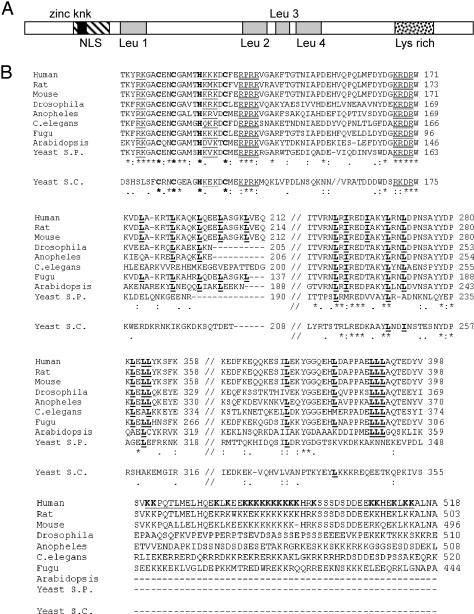Figure 1.
Protein motifs and phylogenetic conservation of hSlu7. (A) Schematic representation of the hSlu7 protein motifs. The respective location of each motif is indicated: NLS (diagonal bared box), zinc-knuckle (zinc knk; black box), four leucine repeats (Leu 1–4; gray shaded boxes), and lysine-rich region (Lys rich; doted box). The protein image is not drawn exactly to scale but is drawn proportionally. (B) Slu7 from 10 different organisms [human (AAD13774); rat (R. norvegicus; sequenced in our laboratory and deposited in GenBank/EMBL/DDBJ; NP_776208); mouse (Mus musculus; XP_126206); Drosophila (Drosophila melanogaster; NP_651659); Anopheles (Anopheles gambiae; AAAB01008968); nematode (Caenorhabditis elegans; NP_505661); Fugu (annotated from www.fugubase.org), Arabidopsis (Arabidopsis thaliana CAB82819); Yeast S.P. (Schizosaccharomyces pombe; NP_596034); and Yeast S.C. (Saccharomyces cerevisiae; A46229)] were aligned along their sequence. Phylogenetic conservation is high within the putative zinc-knuckle amino acids (marked in bold on the first row) but less in the potential NLS regions (single and double underlined on the first row). Semi-conservation is seen in the four leucine-rich regions (bold and underlined “L” in the two center rows). Weak conservation is observed in the lysine-rich region (underlined in the bottom row; the lysine amino acids–K–also are shown in bold). The most conserved amino acids are marked with an asterisk below the alignments. Two dots or one indicate decreasing conservation, respectively. The yeast S. cerevisiae (Yeast S.C.) sequence is written below the main alignment because it possesses the least conserved Slu7 out of the group. Two alignment results are shown; with and without the Yeast S.C. Slu7 sequence. Numbers on the right indicate amino acid location.

